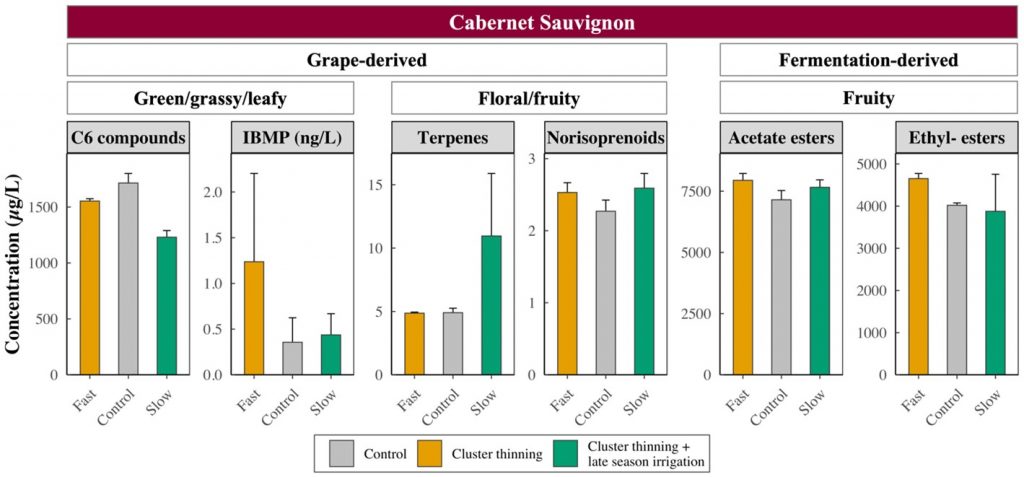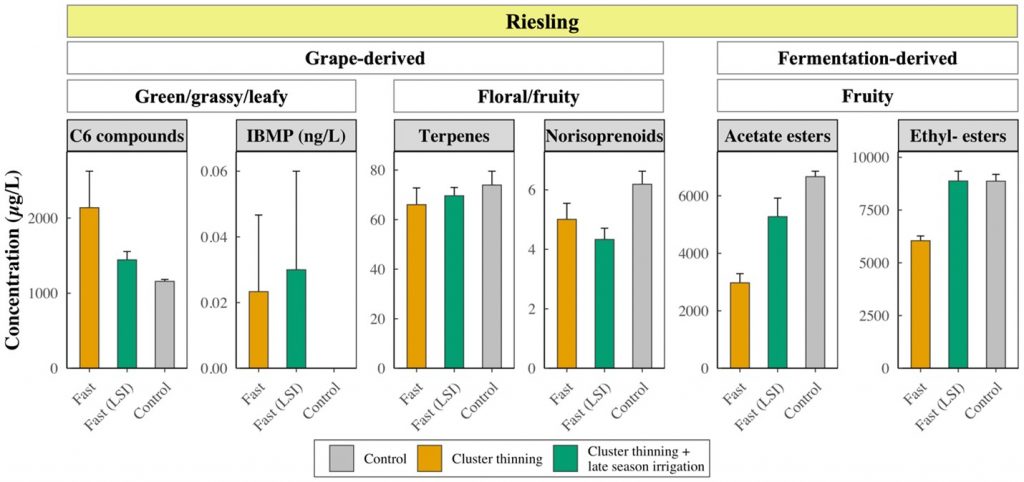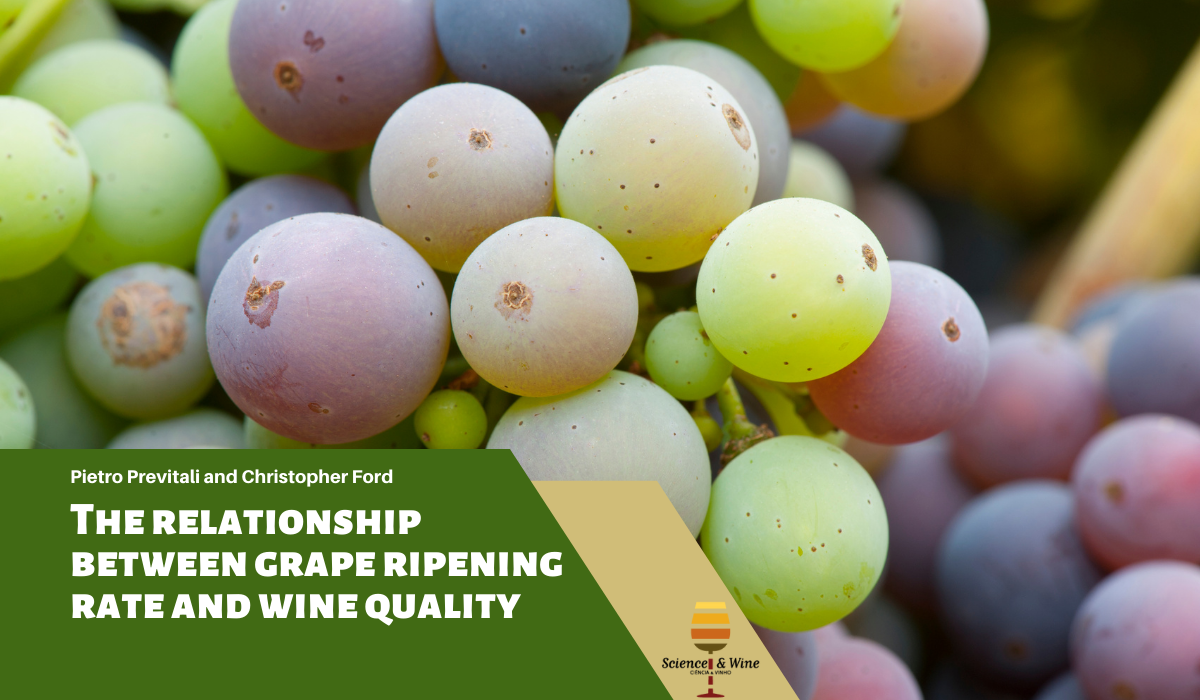By Pietro Previtali and Christopher Ford, ARC Training Centre for Innovative Wine Production and The University of Adelaide, Adelaide, Australia
Grape growers face the consequences of a changing climate, which impact grape yield and quality in several ways. Of particular interest are increasing levels of atmospheric CO2, elevated temperature, and water stress, environmental parameters primarily involved in the regulation of plant metabolism. Fruit composition at harvest is the primary contributor to wine quality and “uniqueness”, thus there is great benefit for growers in understanding the response of grape composition to different climate scenarios.
The process of sugar accumulation, a key feature of grape ripening, is accompanied by the synthesis of other “specialized” metabolites in the fruit. These compounds are responsible for colour and aroma characteristics, two undisputed determinants of the quality of a wine. A concerning trend has been observed in most wine regions where grapes are nowadays accumulating sugars at a faster pace due to increased temperature and CO2 levels. Faster sugar accumulation is not a problem per se, but it becomes detrimental when the same acceleration does not occur for other important colour and aroma compounds. In other words, processes of ripening that were tightly aligned are now occurring at different rates. This phenomenon, described as a “decoupling” between sugars and the “specialized” compounds, is of great importance in grape production, because growers have to compromise between sugars and colour or aroma compounds. If they harvest grapes at the targeted sugar level, the desired alcohol level is maintained but with less colour and aroma; alternatively, growers may decide to wait for the optimal development of colour and aroma, but in this case they are forced to harvest grapes containing more sugar than desired, which means higher potential alcohol and unbalanced wines.
Mitigation strategies are thus needed to delay sugar accumulation in grapes, to restore the balance between sugars and the “specialized” metabolites. The aim of our study was to implement vineyard strategies to delay sugar accumulation and evaluate the effect on wine quality. The experiment was performed in California using Cabernet Sauvignon vines grown in the Lodi American Viticultural Area and Riesling vines in the San Joaquin Valley.
Experimental treatments, namely crop thinning and late season irrigation, aimed at manipulation of the rate of sugar accumulation to obtain faster and slower TSS (Total Soluble Solids, a common measure of grape sugars in the industry) accumulation compared to the control grapes, managed according to the industry standard. Two crop levels were compared: high crop (unmanipulated vines) and low crop (vines cluster-thinned to leave 1 cluster/shoot). Differential irrigation was scheduled remotely in parcels of 170 vines using innovative variable rate drip irrigation systems. The standard irrigation replenished 85 and 70 % of vine evapotranspiration in Cabernet Sauvignon and Riesling vines respectively. To the standard regime was compared a late season irrigation, whereby irrigation amounts were increased by 50 % in the latter stage of ripening. Late season irrigation was applied to Cabernet Sauvignon vines from 20 to 26 °Brix and from 17 to 21 °Brix in the case of Riesling.
The same treatments applied to Cabernet Sauvignon and Riesling led to different outcomes in terms of sugar accumulation (Figure 1). In the Riesling experiment, accumulation of TSS reflected crop load conditions and cluster thinning advanced ripening by 3 weeks. In neither high or low crop load, late season irrigation affected the rate of sugar accumulation of Riesling grapes. In Cabernet Sauvignon, the four treatments led to three distinct kinetics of sugar accumulation, where cluster thinning and the combination thereof with late season irrigation led to a faster and slower sugar accumulation respectively. There was no effect on berry or cluster weight in grapes of Cabernet Sauvignon, indicating that treatment differences were not the result of concentration or dilution effects. Aspects of grape ripening, vine physiology and grape chemistry for Cabernet Sauvignon are available in our article published in the Journal of Agricultural and Food Chemistry (https://pubs.acs.org/doi/10.1021/acs.jafc.1c01229). Although late season irrigation may be a promising strategy to delay ripening, our study has shown that its efficiency is dependent upon the range of TSS maturity (e.g. Riesling vs Cabernet Sauvignon) and vine crop load (i.e. the balance between leaf area and fruit weight). These aspects deserve further investigation before late season irrigation can be proposed as a vineyard practice for viticulturists.

The three distinct kinetics of sugar accumulation in Cabernet Sauvignon offered a unique opportunity to evaluate the relationship between rate of ripening and wine composition (the full article is available at https://doi.org/10.1016/j.foodchem.2021.131406). The analysis of the chemical composition of Cabernet Sauvignon wines displayed a beneficial effect of delayed sugar accumulation, simply referred to as “delayed ripening” (Figure 2). Delayed ripening increased the concentration of terpenes and norisoprenoids, grape-derived aroma compounds responsible for fruity and floral notes. In turn, the abundance of C6 compounds and IBMP was decreased in the slow-ripening grapes, with a beneficial effect on wine quality due to these compounds being responsible for green, grassy or leafy attributes unwanted in red wines. As for fermentation-derived esters, responsible for pleasant fruity notes, different rates of ripening did not result in significant changes in the final Cabernet Sauvignon wines. Wine phenolic compounds, involved in wine colour and mouthfeel properties, were also improved or remained unchanged in wines from slow-ripening grapes, which confirms previous reports where wine colour was improved when sugar accumulation was delayed by means of vineyard practices.

In Riesling, it was not possible to fully separate the effect of the ripening rate from that of the experimental treatments due to the lack of a “slow” ripening (Figure 1). However, there were significant differences in the concentration of important aroma compounds in Riesling wines ripening at the same rate, namely fast (cluster thinning) and fast with LSI (Figure 3). The addition of LSI to cluster-thinned vines resulted in lower concentrations of C6 compounds and higher concentrations of fruity esters, shifting the composition of aroma compounds of fast-ripening grapes to a similar profile to the control harvested 3 weeks later. Such “decoupling” effect of LSI on the certain aroma compounds needs to be addressed in future research.

Our study has explored the effect of different rates of sugar accumulation on wine composition, highlighting improved wine quality as a result of a slower ripening process. These results further demonstrate the importance of achieving a correct rate of ripening to improve grape potential for winemaking. Additionally, the importance of adopting mitigation strategies whenever sugar accumulation is too fast is stressed, especially in response to hotter and drier field conditions.
This work was supported by the Australian Research Council Training Centre for Innovative Wine Production, funded by the Australian Government with additional support of Wine Australia and E. & J. Gallo Winery.

